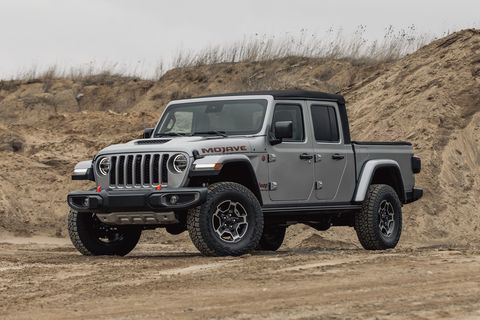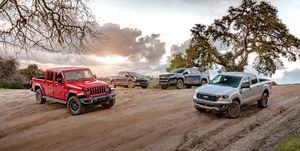View Photos

Michael SimariCar and Driver
We may cherish sports cars here at C/D, but we’re no strangers to the joys of off-road driving. Fewer rules. Ever-changing terrain. The high of conquering Mother Nature with all of a vehicle’s drivetrain (hopefully) still intact. But we’re impatient. And clambering over rocks and through mud in production vehicles is too often a tedious, slow-paced affair short on adrenaline. Add Jeep to the handful of manufacturers that understand this. The 2020 Jeep Gladiator Mojave is the first of the brand’s Desert Rated vehicles to have been engineered for high-speed off-road performance.
Witness the Ford F-150 Raptor, Chevy Colorado ZR2, and Toyota’s TRD Pro models for the burgeoning popularity of desert-racing-inspired production vehicles. The Mojave is essentially a lightly modified Gladiator Rubicon, which we already consider to be the best version of the 10Best-worthy Gladiator pickup. For the Mojave, that means it arrives with one of Jeep’s top Trail Rated rigs: 33-inch-tall tires, stout live axles with 4.10:1 gears, and a two-speed low-range transfer case. It’s just more athletic. Whereas the Rubicon excels at methodically navigating rocks and trails, the Mojave has been fortified to charge through the wide-open rough at greater speeds. Think of the Mojave as a parkour specialist to the Rubicon’s free climber.
Bulking Up
Jeep actually hinted at this a few years ago with its Sandstorm concept. While the production Mojave is far tamer than that custom, V-8-powered beast, it does boast some meaningful enhancements. Compared to the Rubicon, a 1.0-inch front suspension lift provides more wheel-well clearance for the new 2.5-inch Fox internal-bypass dampers. These are not only tuned to better absorb large impacts but, thanks to external fluid reservoirs, are more efficient at dissipating the heat buildup that can sap a damper’s effectiveness. Going a step further, secondary Fox hydraulic jounce dampers—heavy-duty, short-stroke shock absorbers common on off-road racing vehicles—take the place of the front bump stops to help prevent the suspension from bottoming out.
If you do manage to get air between the Mojave’s standard Falken Wildpeak All-Terrain tires and the ground, know that Jeep has strengthened its ladder frame at the suspension’s mounting points to better withstand hard landings. It also gets model-specific cast-iron steering knuckles, a stiffer rear axle made of thicker tubing, a larger-diameter rear track bar with larger bushings, and a 0.5-inch-wider track from standard 17-inch wheels with a slightly greater offset. The goal of these modifications is to improve high-speed stability and toughness over gnarly, uneven terrain.
The Mojave employs the same 285-hp 3.6-liter V-6 as other Gladiators, as well as a choice of standard six-speed manual or optional eight-speed automatic transmissions. However, its four-wheel-drive transfer case is shared with non-Rubicon models and features a taller 2.72:1 low-range ratio, which allows for a higher top speed in 4LO than the Rubicon’s 4.00:1 granny gear. While the Mojave does without the Rubicon’s electronic disconnecting front anti-roll bar and locking front differential, its standard electronic locking rear differential can be engaged in 4HI high range; the Rubicon’s lockers work in low range only. Tying the Mojave’s chassis and drivetrain electronics together is an Off-Road Plus drive mode. Activated by a button on the center stack, the system adjusts the V-6’s throttle response and relaxes the calibrations for the ABS and traction and stability controls for desert-running conditions.
Fundamental Limitations
Where the Mojave breaks the performance off-road mold is with its solid front axle. Most desert racers abandoned the front stick axle long ago, exchanging it for the greater steering precision and control an independent front suspension (IFS) offers. Even some hard-core rock bouncers have made the switch to IFS. That makes the Mojave a bit of a hybrid. It may be able to tackle a desert wash quicker and more controllably than a Gladiator Rubicon, but it still has the ruggedness to handle most of the same trail work. Just remember that while the Gladiator’s ride quality and high-speed stability benefit from its long 137.3-inch wheelbase, this crew-cab pickup also will rub its belly on large rocks and steep breakovers.
With both our local off-road park and Michigan’s Silver Lake sand dunes temporarily closed, our full report on the Mojave’s capabilities will have to wait. But even light urban off-roading reveals that the Mojave soaks up big impacts and curb strikes with less drama and bucking than the Rubicon model. It does not levitate over bumps on a magic carpet of shock fluid like Ford’s Raptor. The Mojave is still a burly production Jeep far removed from a desert pre-runner, but its overall ride comfort is slightly better than the Rubicon’s. Its tendency to wander in its lane at highway speeds is slightly worse. And, despite the big off-road rubber, there’s a decent sense of security when you pitch it into a corner, albeit zero sense of feel through the steering wheel.
Orange You Impressed?
You likely won’t notice the Gladiator Mojave’s front suspension lift unless its parked next to a Rubicon model. But its other tells are more obvious: a performance hood with a faux scoop and bold Mojave decals, orange paint on the tow hooks in place of the Rubicon’s red, and rugged steel slider rails for protecting the rocker panels. The orange theme continues on the inside. There’s contrast stitching on the dash and steering wheel, as well as on the Mojave-embroidered sport seats, which provide a little more side support without pinching average-size frames. A starting price of $45,370 mirrors that of the Gladiator Rubicon, which means the Mojave can get expensive fast with extras. A hefty load of options—from the automatic transmission to leather upholstery to an 8.4-inch infotainment touchscreen—pushed ours to $61,295.
Jeep has yet to detail the future of its Desert Rated lineup. A Wrangler Mojave, which would compete with the all-but-guaranteed Raptor-ized version of the new Ford Bronco, is a given. But a Desert Rated version of each of Jeep’s SUVs is less certain, thanks to the substantial development the necessary suspension improvements would require. Pushed hard enough, even a $1500 beater can be an off-road hero. But you won’t make it far into the cacti without the proper equipment, and you’ll batter your kidneys in the process. For Jeepers searching for dirt and speed, the Gladiator Mojave opens up a new off-road skill set.
Source: Reviews - aranddriver.com










